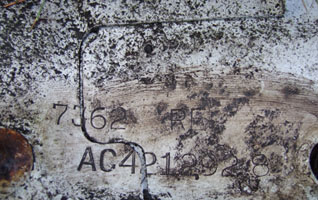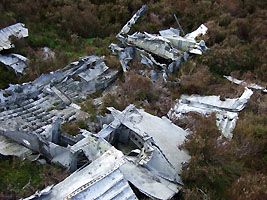 |
P-38 42-12928
- Baxton Fell
26th January 1943 |
 |
P-38 42-12928
- Baxton Fell
26th January 1943 |
Updated 14.11.2010
| Type | Unit | Base | Duty | Crew | Passengers |
| P-38F | 82nd Fighter Squadron, 78th Fighter Group, US 8th AAF | Goxhill | Ferry flight | 1 | - |
Though this incident involved a collision between the subject aircraft and P-38 42-12905, they have been treated separately to avoid confusion between the two crash sites, though the historical background text is by necessity basically the same on both pages. Much of the information on this incident is to be found in Garry L. Fry's book "Eagles of Duxford" (US: Phalanx, 1991. ISBN 0962586021) as unfortunately no crash record has been traced.
Mid January 1943 saw the decision being made to urgently ship the US 8th Air Forces P-38 Lightning aircraft to North Africa and to re-equip the 78th Fighter Group with P-47 Thunderbolts for their forthcoming escort duties. This required the P-38s to be flown to BAD 3 (Base Air Depot) Langford Lodge in Northern Ireland for the required modification for use in dusty climates, before they were flown on to North Africa. Early on the morning of the 26th January a large group of some 45 such aircraft were en-route to Ireland from the groups base at Goxhill in Lincolnshire, when they encountered heavy cloud over the North of England. Struggling to maintain formation in deteriorating visibility, two of the aircraft collided over the high ground of the Trough of Bowland and fell to earth almost immediately. Neither pilot made any apparent attempt to escape their stricken aircraft, perhaps due to injury, or having been killed in the initial collision and the two aircraft crashed with a mile and a half of each other on the bleak Lancashire moorland below. The same day a further 78th Fighter group pilot was lost en route to North Africa, ferrying one of the modified P-38s from Ireland. The loss of these three pilots was a serious blow to moral within the group as they were the first casualties since arriving in England.
| Name | Position | Status |
| 2nd Lt. S.L. White | Pilot | K. |
The crash site on Baxton fell is the more substantial of the two with a couple of fairly large sections of wing remains present, surrounding an area where part of the aircraft clearly burnt out. Several years ago an enthusiast had gathered together a number of sections of "Alclad" skinning and pieced them together like a jigsaw puzzle, revealing the shape of part of the underside of the center section of the P-38, suggesting that the aircraft had impacted inverted. Also on one visit in the 1980s signs of recent digging were noted together with two stainless steel ammunition containers from the aircraft’s nose, one for .50 calibre and the other for the 20mm cannon. It appeared the digger had been disturbed and forced to abandon his prize, needless to say the two items were found a good home! Despite such activities much of the wreckage still lies at the site, providing a memorial to a pilot killed on what should have been a routine flight on the eve of going into action.
| "Burnt" area of the crash site |
Ammunition containers, 20mm top, .50 bottom |
Section of wing root lying close to the "burnt" area |
Update November 2008: A site visit was made in March 2008 to the crash site of P-38 42-12905 following information received, via email from a walker who we had given location details to enable him to find the site, to say that a small fragment possibly bearing the aircraft's serial number had been found amongst the few debris still remaining. As the official investigation records are still unavailable in the US archives, it has never been possible to establish with any certainty which crash site is actually the remains of which aircraft. My youngest son soon located the fragment and it did indeed bear the aircraft's serial number and manufacturers construction number. Though this was not conclusive proof of identity as, although unlikely, it is possible that it could have dislodged from either aircraft in the collision. It was however, proof that the cowlings and removable panels of these aircraft were marked - if you knew where to look, as the markings were relatively small. We carried on and attempted to locate the second crash site that day, but changing weather conditions and lack of time beat us, so a follow up visit was made in November and now that we knew what to look for, we examined as many of the removable panels as possible still remaining at this crash site to see if any bore similar small sets of stamped identification numbers. The first couple of panels we found on the approach to the site were not marked - but then the third panel was indeed marked and it was "42-12928" plus the correct makers construction number. We went on to find and photograph five panels in total - all marked with the same numbers, meaning that we had definitely identified this site and therefore confirmed that of the Dunsop Fell site as well..
 |
 |
|
The first marked panel at the site. |
Full set of photos from this visit is on flickr |
Garry L. Fry (Eagles of Duxford), Peter Moran. Rich Allenby, Alan Hudson.
This page & all articles on this site Copyright © Nick Wotherspoon 2000